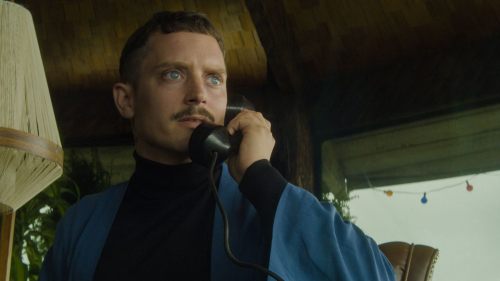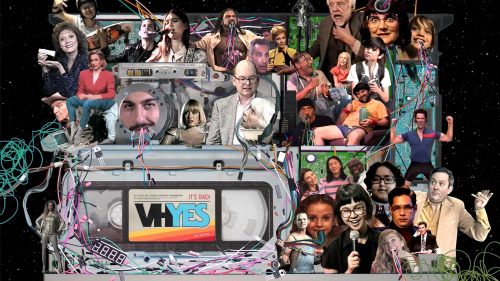Fantastic Fest Shorts: FEAR AUDIBLY And The Mysterious Emotions Of Sound
An abaya-clad girl walks home alone at night, as speakers from prayer minarets harken the coming of doom. Right from its opening frames, Maha Al-Saati’s Fear Audibly places us in a zone of auditory discomfort before discombobulating further through a tale of media allure and the clash of the natural and man-made. It’s also about a teacher getting lost in her student’s film project and cats trapped in an office ceiling (among a dozen other things) and talking to her about her weird twenty-minute short might have been the highlight of my Fantastic Fest.
Check out the trailer:
Maha is a teacher of media – first in Saudi, then in Vancouver, now in Saudi again – and our chat spanned well over an hour, covering everything from perceptions of gender and sexuality in cinema to the increased prominence of New Media in Saudi both as entertainment and learning tool, all of which find their way into her work. Fear Audibly is one of those abstract, poetic films that sounds downright bizarre on paper (the teacher fails to track down the male poet in her student’s video so she begins obsessing over the girl who made it – and again, cats in the ceiling) and unlike most zero-budget short films, its sound design is where it truly finds itself.
I wish I could simply upload the raw hour+ recording of all we talked about at Caffe Medici, the refuge for weary critics Fest-goers in between screenings. It would be fitting given the film’s auditory focus, and it was fascinating to gain insight from someone who left Saudi and moved back (I left when I was five and I’m not sure I’ll return), not to mention someone who’s seen the evolution of media, religion and youth culture there, but I’m afraid you’ll have to settle for the abridged version of the interview while Fear Audibly makes the festival rounds. Don’t worry. It’s still delightful.
Siddhant: Your film feels very sound-dependent, and for a lot of short filmmakers that ends up being a roadblock. Was that something you had to be careful of going in?
Maha: For me the idea of sound, floating in the air and being source-less has always been fascinating. Because of the focus on it in the Islamic tradition, there’s always been—I’m sorry.
A few moments in to our interview, Maha spots a bird hobbling around by the tree we were seated under. It doesn’t show any visible signs of injury, but it isn’t flying away either.
Maha: It’s hurt, is it?
S: I have no idea.
M: I think it’s hurt. Sorry! Back to the interview. I’m very sympathetic towards animals. That’s why even the strongest concept in the narrative was basically the cats, so I notice animals in pain. I hate their suffering.
Going back to the sound aspect, what inspired it is that growing up in Saudi Arabia in the ‘80s and ‘90s there was always a restriction on visuals, right? So there was a dependency on audio. Preachers used cassette tapes a lot, so a lot of the things that we hear, the stories, they’re always sound based. The narrative is always non-visual. In the Islamic tradition, even the ending of time was signaled by the trumpet of doom. Hearing all these stories when I was growing up was very scary to me. That’s why I end up thinking or dreaming about it sometimes. That’s why even when I left Saudi Arabia in 2006, even being in such a secular surrounding in Vancouver, every time I would hear an unknown sound coming from afar, subconsciously I would think about the narratives I heard as a child. So I would hear a fire truck and the few seconds that would precede the sound coming all the way and being identifiable, I would immediately think of the narratives that sunk in since my childhood.
I’ve also listened to a lot of psychoanalysis by Slavoj Žižek. He was talking about the disembodiment of sound, and how if we see something we can kind of identify what it is, but if we don’t see it, it’s just floating in a disembodied way. It’s kind of unnatural, like a ghost.
At the same time there were several types of sounds I wanted to capture in the movie, like the sound of seductiveness. The part where the girl listens to this video and there’s the sound of a man but she can’t identify who that man was. She searched for him, and she was very attracted to the voice of the man, but because she couldn’t name the source, again, it’s a source-less seductive sound, so she traced it to the best of her ability to the girl, and that’s why she ended up being obsessed with the girl, because she couldn’t find the guy.
In that area I wanted to explore sexuality in a way, because sometimes you’re attracted to certain features in a person, and we tend to genderize, or we tend to associate certain attributes, so a man should have a manly voice and a girl should have a soft voice, so I wanted to explore that mix up. What if the girl doesn’t have that typical girly voice, and she has a sound that’s deeper? I wanted to explore that area of attractiveness, which happened to be through the gateway of source-less sound.
S: What about the sound of the kittens? We never actually seem either, except in the character’s dream.
M: That was the sound of nature invading the office space, which is supposed to be clean and civilized. Everyone’s working and everything is functional, so suddenly the invasion of nature through the ducts of the AC was chaotic. They want to be fed, they want to be loved, and in a way that call was the sound of affection. You want to be wanted, and in a way the character felt that connection with the kittens.
S: I also noticed the prominence of screens in your film. They’re becoming such a big part of our collective consciousness, whether it’s the television or the character teaching media. She’s also dreaming about the film she was shown, so she almost gets sucked into it, like she’s living in the screen.
M: It’s very interesting, I love having screens in my movies but in real life I don’t have any screens. When I lived in Canada for seven years I did not have a TV. I dislike screens! I dislike when people look at their screens and their phones while I’m talking to them. I love eye-to-eye contact, but at the same time, I don’t know why I’m fascinated by screens IN the film. They’re somehow a very literal interpretation of the visual I want to convey. I like the flashing of the TV screen in her face. I like to capture these bizarre images I saw on YouTube, like a comet falling. YouTube videos are very fascinating, so a lot of the knowledge that I have is not just by reading books because I don’t have the time, so I end up listening to lectures or sometimes I put on a YouTube show and just listen. In a way it did shape a lot of my worldview.
S: There’s almost a romantic undertone to the video in your film, but as opposed to displaying through sex it’s through media, like that almost becomes the mechanism for it.
Yes. Yes, I didn’t intend for it to be sexual, and the character denies it later on. There’s a tendency for films to be very sexual these days, with the growth of LGBT awareness. There’s a tendency to go more towards sex between similar genders, but I think it’s limiting. There are all sorts of attractions that aren’t just sexual. You could be obsessed with a person because of their ideas, which is why I wanted to liberate it from sex and make it some kind of obsession, but she really doesn’t understand what that obsession is. When she ran to her ex boyfriend she wanted to regain a sense of normality, but he rejects her and that leaves her confused. She wanted that reassurance that she is still a girl in need of the support of a man, she wants to be conventional. I don’t know if I answered the question?
S: Don’t worry, you did! Like you said, removing the literal manifestation of sex from the equation, what we’re left with in the form of media are the more complicated aspects of relationships.
M: Yes.
S: Do you think the film she’s watching is, in a way, an exploration of those thoughts and feelings we don’t normally touch on in cinema?
M: I think so, but for me it was still a very vague idea that I didn’t know much about. For me it comes back to what we were talking about earlier. You can tend to be attracted towards a trait associated with a certain gender, like a deep voice, and I wanted to remove it. What if we remove that trait that makes you attracted to a certain gender and keep it very abstract? It can go for hair as well, like we tend to associate long hair with girls and short hair with men, and if there’s a flip there’s confusion. Like “Why does that girl have hair like a man?” Maybe it’s not the case here, but in Saudi Arabia they tend to have a term for these girls who cut their hair very short. They would call them “boya,” referring to “boy.” So she’s a boy, but a girly boy, or something like that. And those girls who tend to have deeper voices or male characteristics or short hair, if there’s another girl attracted towards them she’s “not a good person,” but for me, the questions is: is she attracted towards the girl, or is she attracted to the traits often associated with boys but are now implemented on girls? For me it was confusing, so I wanted to explore that.
S: There definitely was that sense of confusion within the video as well, because you do super-impose the girl’s face over the man’s.
M: And the man’s voice.
S: So there’s no clear distinction between gendered traits in this space that she enters.
M: Yes. When we dream we tend to want to put sound into a visual format, so that’s why she kept on thinking about the voice. She couldn’t put a face to it, so she put the girl’s face to it because that’s the only source she had. Had she been able to find the guy behind the poem, would she be more attracted to him than to the girl? I’m not sure.
Fear Audibly played during the “Yalla! Arab Genre Shorts” section of Fantastic Fest



